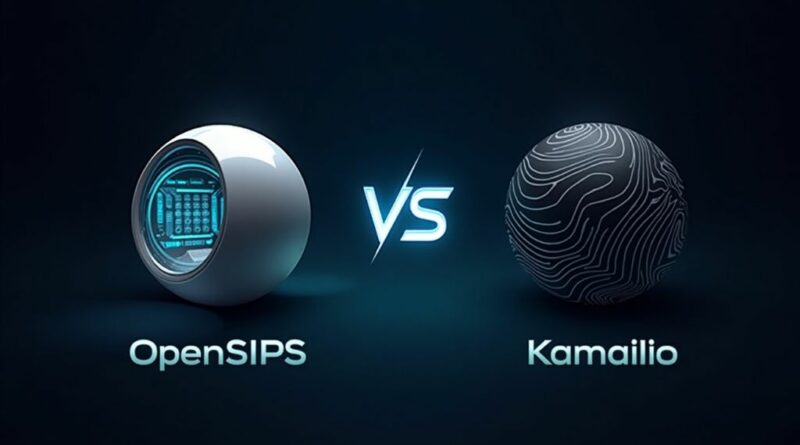🏆 OpenSIPS vs Kamailio: Which Reigns Supreme in 2025?
The debate between OpenSIPS and Kamailio has been echoing through VoIP and telecom communities for over a decade. As we enter 2025, the question remains just as relevant — which SIP server is better for high-performance, carrier-grade, and WebRTC-ready applications?
If you’re designing a modern VoIP infrastructure or building scalable SIP routing for real-time communication, this guide will help you weigh the pros and cons of each platform.
🚀 The Origins: A Tale of Two SIP Servers
Both OpenSIPS and Kamailio trace their roots back to the now-defunct SER (SIP Express Router) project, which split in the mid-2000s. Since then, the two projects have diverged in architecture, philosophy, and community dynamics, yet remain remarkably close in features.
- OpenSIPS has focused on high performance, modularity, and extensibility, making it a favourite in large-scale deployments.
- Kamailio, on the other hand, is praised for its configuration flexibility, robustness, and extensive scripting capabilities.
🔧 Core Use Cases in 2025
In 2025, both platforms have matured to support virtually all SIP features: NAT traversal, load balancing, SIP WebRTC gateways, TLS, authentication, and even custom back-end scripting. However, they tend to dominate different verticals:
| Feature | OpenSIPS | Kamailio |
|---|---|---|
| Load Balancing | ✅ Excellent (dispatcher module) | ✅ Very good |
| SIP Trunking | ✅ Built-in support | ✅ Requires config tuning |
| Presence and IMS | ✅ Moderate support | ✅ Stronger support |
| WebRTC Gateway | ✅ Strong (with RTPEngine) | ✅ Also strong (RTPEngine support) |
| Embedded Scripting | ✅ Lua, Python, JavaScript | ✅ Native scripting (cfg) |
🔌 Bonus Tip:
Need to integrate with WebRTC? Pair either SIP proxy with RTPEngine and a TURN server like coturn for a robust setup.
⚙️ Configuration & Scripting: Who Wins?
This is where the philosophical difference becomes evident:
- OpenSIPS uses a C-style configuration file, but now also supports embedded scripting languages like Lua, Python, and JavaScript.
- Kamailio relies heavily on its own domain-specific scripting language, which offers unmatched flexibility — but comes with a steeper learning curve.
🧠 Best for developers? OpenSIPS might feel more familiar due to embedded languages.
🧠 Best for telecom veterans? Kamailio’s native config shines with raw SIP power.
📊 Performance Benchmarks
OpenSIPS has a strong reputation for handling millions of calls per day with low memory consumption. This makes it ideal for setups where load distribution and performance tuning are paramount.
Kamailio is no slouch either — with optimised modules and smart routing logic, it’s used in some of the largest telecom networks globally, including by carriers and VoLTE providers.
Want real metrics? See this OpenSIPS performance report and Kamailio scalability reference.
🤝 Community & Support
| Factor | OpenSIPS | Kamailio |
|---|---|---|
| Commercial Support | ✅ OpenSIPS Solutions | ✅ Asipto, others |
| Community Forums | ✅ OpenSIPS Users List | ✅ Kamailio Mailing Lists |
| Documentation | ✅ Excellent | ✅ Good, but scripting-heavy |
| GitHub Stars | ⭐ ~1.4k | ⭐ ~1.7k |
Both communities are passionate and helpful, though Kamailio has a larger developer base. That said, OpenSIPS documentation is generally more accessible for beginners.
🧩 Choosing Between OpenSIPS and Kamailio
Ultimately, your choice should align with your deployment goals:
Choose OpenSIPS if you:
- Need fast deployment and modern scripting support
- Are building a scalable SBC or SIP load balancer
- Prefer strong support for real-time metrics and clustering
Choose Kamailio if you:
- Want granular SIP control and robust IMS features
- Are familiar with its native scripting language
- Need carrier-grade routing with tight security controls
🏁 Final Thoughts
In 2025, both OpenSIPS and Kamailio remain powerful, reliable, and production-ready SIP servers. The best choice depends on your experience, project needs, and preferred configuration style.
If you’re building a modern VoIP stack or WebRTC gateway, these platforms are not just viable — they’re essential pillars of the open-source telecom landscape.
We’d love your questions or comments on today’s topic!
For more articles like this one, click here.
Thought for the day:
“A champion is afraid of losing. Everyone else is afraid of winning.” Billie Jean King



